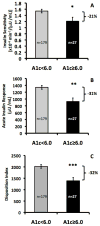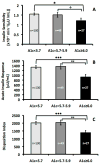Hemoglobin A1c above threshold level is associated with decreased β-cell function in overweight Latino youth
- PMID: 22137671
- PMCID: PMC3297692
- DOI: 10.1016/j.jpeds.2011.10.024
Hemoglobin A1c above threshold level is associated with decreased β-cell function in overweight Latino youth
Abstract
Objective: To examine whether a hemoglobin A1c (HbA1c)-identified prediabetic state (HbA1c ≥ 6.0%-6.4%) is associated with decreased insulin sensitivity (SI) and β-cell dysfunction, known factors in the pathogenesis of type 2 diabetes, in an overweight pediatric population.
Study design: A total of 206 healthy overweight Latino adolescents (124 males and 82 females; mean age, 13.1 ± 2.0 years) were divided into 2 groups: lower risk (n=179), with HbA1c <6.0%, and higher risk (n=27), with HbA1c 6.0%-6.4%. Measurements included HbA1c, oral glucose tolerance testing, fasting and 2-hour glucose and insulin, SI, acute insulin response, and disposition index (an index of β-cell function) by the frequently sampled intravenous glucose tolerance test with minimal modeling. Body fat was determined by dual-energy X-ray absorptiometry.
Results: Compared with the lower risk group, the higher risk group had 21% lower SI (1.21 ± 0.06 vs 1.54 ± 0.13; P<.05), 30% lower acute insulin response (928 ± 102 vs 1342 ± 56; P<.01), and a 31% lower disposition index (1390 ± 146 vs 2023 ± 83; P=.001) after adjusting for age and total percent body fat.
Conclusion: These data provide clear evidence of greater impairment of β-cell function in overweight Latino children with HbA1c 6.0%-6.4%, and thereby support the adoption of the International Expert Committee's HbA1c-determined definition of high-risk state for overweight children at risk for type 2 diabetes.
Copyright © 2012 Mosby, Inc. All rights reserved.
Conflict of interest statement
The authors declare no conflicts of interest.
Figures


References
-
- Tripathy D, Carlsson M, Almgren P, Isomaa B, Taskinen MR, Tuomi T, et al. Insulin secretion and insulin sensitivity in relation to glucose tolerance: lessons from the Botnia Study. Diabetes. 2000;49:975–80. - PubMed
-
- Kim DJ, Lee MS, Kim KW, Lee MK. Insulin secretory dysfunction and insulin resistance in the pathogenesis of korean type 2 diabetes mellitus. Metabolism. 2001;50:590–3. - PubMed
-
- Festa A, D’Agostino R, Jr, Hanley AJ, Karter AJ, Saad MF, Haffner SM. Differences in insulin resistance in nondiabetic subjects with isolated impaired glucose tolerance or isolated impaired fasting glucose. Diabetes. 2004;53:1549–55. - PubMed
Publication types
MeSH terms
Substances
Grants and funding
LinkOut - more resources
Full Text Sources
Medical

